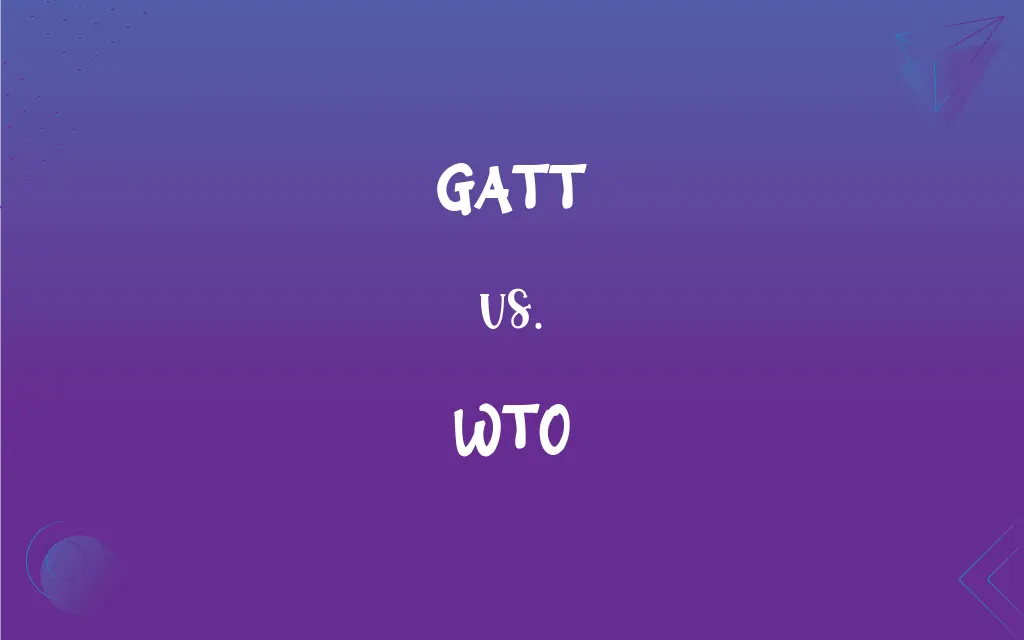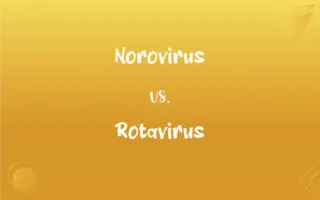GATT vs. WTO: What's the Difference?
Edited by Aimie Carlson || By Janet White || Published on June 17, 2024
GATT (General Agreement on Tariffs and Trade) was a series of rules for international trade; WTO (World Trade Organization) is an institutional body that governs world trade.

Key Differences
The General Agreement on Tariffs and Trade (GATT) was established in 1947 as a legal framework for international trade. Its main focus was on reducing tariffs and other trade barriers. The World Trade Organization (WTO), established in 1995, succeeded GATT, expanding its scope. While GATT was primarily a set of rules, the WTO is an institutional body with broader authority in global trade matters.
GATT was a multilateral agreement that laid the groundwork for reducing trade barriers and was mainly focused on goods. It went through several negotiation rounds, aimed at tariff reduction. The WTO, on the other hand, encompasses not only goods but also services and intellectual property. It provides a platform for negotiating trade agreements and settling trade disputes.
The structure of GATT was simpler, functioning more as an agreement than an organization. It operated under a consensus-based approach and lacked a formalized institutional structure. The WTO is a comprehensive organization with a well-defined structure, including a Secretariat, councils, and committees. It also has a more formal process for dispute resolution.
GATT's influence was significant in the post-World War II era, setting the stage for international trade. However, it was limited in addressing new trade challenges. The WTO, in contrast, provides a robust framework for addressing contemporary trade issues, including those related to digital trade, environmental concerns, and labor standards.
Membership in GATT was less formal, with countries adhering to the agreement without needing full ratification. WTO membership, however, requires a more rigorous accession process, reflecting its broader scope and more formal status as an international organization.
ADVERTISEMENT
Comparison Chart
Nature
A set of rules for international trade
An institutional body for trade governance
Focus
Mainly goods
Goods, services, and intellectual property
Structure
Less formal, agreement-based
Formal organization with a defined structure
Scope of Issues Addressed
Mainly tariffs and trade barriers
Wide range including trade policies, disputes, and global issues
Membership and Accession
Less formal adherence
Formal accession process
ADVERTISEMENT
GATT and WTO Definitions
GATT
GATT functioned as a multilateral framework guiding international trade.
Under GATT, countries negotiated to lower tariffs on imported goods.
WTO
WTO works towards reducing trade barriers and promoting open trade.
The WTO's Doha Round focuses on lowering trade barriers for developing countries.
GATT
GATT was a precursor to the WTO, focusing on goods trade.
GATT's limitations in services trade led to the establishment of the WTO.
WTO
The WTO governs international trade rules and settles trade disputes.
The WTO played a key role in resolving the trade dispute between Country A and B.
GATT
GATT, established in 1947, aimed to reduce trade barriers and tariffs.
The 1986 GATT Uruguay Round led to significant tariff reductions globally.
WTO
WTO membership requires countries to adhere to established trade rules.
Joining the WTO requires countries to align their trade policies with WTO agreements.
GATT
GATT provided the foundational rules for modern international trade.
GATT's principles were pivotal in shaping post-WWII global trade policies.
WTO
WTO, established in 1995, expanded the scope of GATT.
The WTO introduced agreements covering services and intellectual property.
GATT
GATT operated through a series of negotiation rounds for trade liberalization.
The GATT Tokyo Round introduced new trade rules beyond tariff reductions.
WTO
WTO offers a platform for negotiating global trade agreements.
The WTO negotiations aim to create fairer trade conditions for all member countries.
GATT
A United Nations agency created by a multinational treaty to promote trade by the reduction of tariffs and import quotas.
WTO
An international organization based in Geneva that monitors and enforces rules governing global trade
GATT
A United Nations agency created by a multinational treaty to promote trade by the reduction of tariffs and import quotas
FAQs
How did GATT influence international trade?
GATT set the foundation for modern trade policies and tariff reduction.
Is GATT still in operation?
No, GATT was succeeded by the WTO in 1995.
What was the primary goal of GATT?
To reduce tariffs and trade barriers among member countries.
How many rounds of negotiations did GATT have?
GATT had a total of eight negotiation rounds.
How does WTO's dispute settlement mechanism work?
It involves a panel and appellate process to resolve trade conflicts.
Was GATT focused only on goods?
Yes, GATT primarily dealt with trade in goods.
Can WTO enforce its decisions?
Yes, WTO decisions are binding for its members.
What additional areas does WTO cover compared to GATT?
WTO covers services, intellectual property, and broader trade issues.
Is WTO a global organization?
Yes, WTO is an international organization with global membership.
How does WTO impact global trade policies?
WTO sets and enforces rules that shape global trade policies.
What is the WTO's main function?
To govern international trade and resolve trade disputes.
Can any country join the WTO?
Yes, but they must go through a rigorous accession process.
Did GATT have a specific focus on developing countries?
Not specifically, but it led to policies beneficial to some developing nations.
What was a significant achievement of GATT?
Significant reduction in global tariffs and trade barriers.
What happens if a country violates WTO rules?
It may face trade sanctions or penalties from other member countries.
How does WTO address environmental concerns?
WTO considers environmental policies in its trade agreements and disputes.
What is the future role of WTO in global trade?
To continue adapting to new trade challenges and fostering fair global trade practices.
Did GATT have a formal institutional structure?
No, it functioned more as a set of rules without a formal structure.
Was GATT successful in its objectives?
Yes, it played a key role in liberalizing global trade post-WWII.
Can non-member countries benefit from WTO?
Indirectly, through more stable and predictable international trade norms.
About Author
Written by
Janet WhiteJanet White has been an esteemed writer and blogger for Difference Wiki. Holding a Master's degree in Science and Medical Journalism from the prestigious Boston University, she has consistently demonstrated her expertise and passion for her field. When she's not immersed in her work, Janet relishes her time exercising, delving into a good book, and cherishing moments with friends and family.
Edited by
Aimie CarlsonAimie Carlson, holding a master's degree in English literature, is a fervent English language enthusiast. She lends her writing talents to Difference Wiki, a prominent website that specializes in comparisons, offering readers insightful analyses that both captivate and inform.






































































